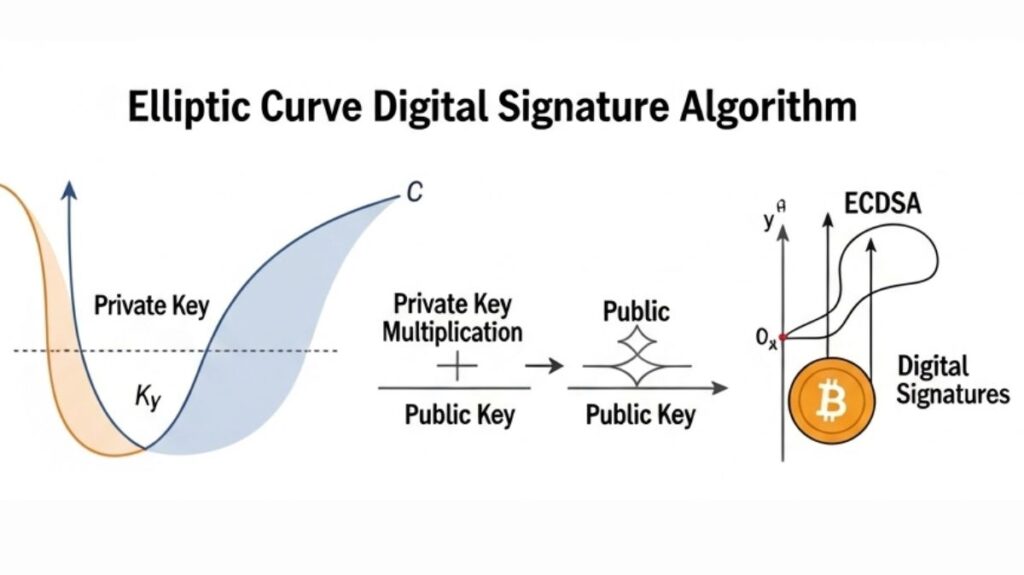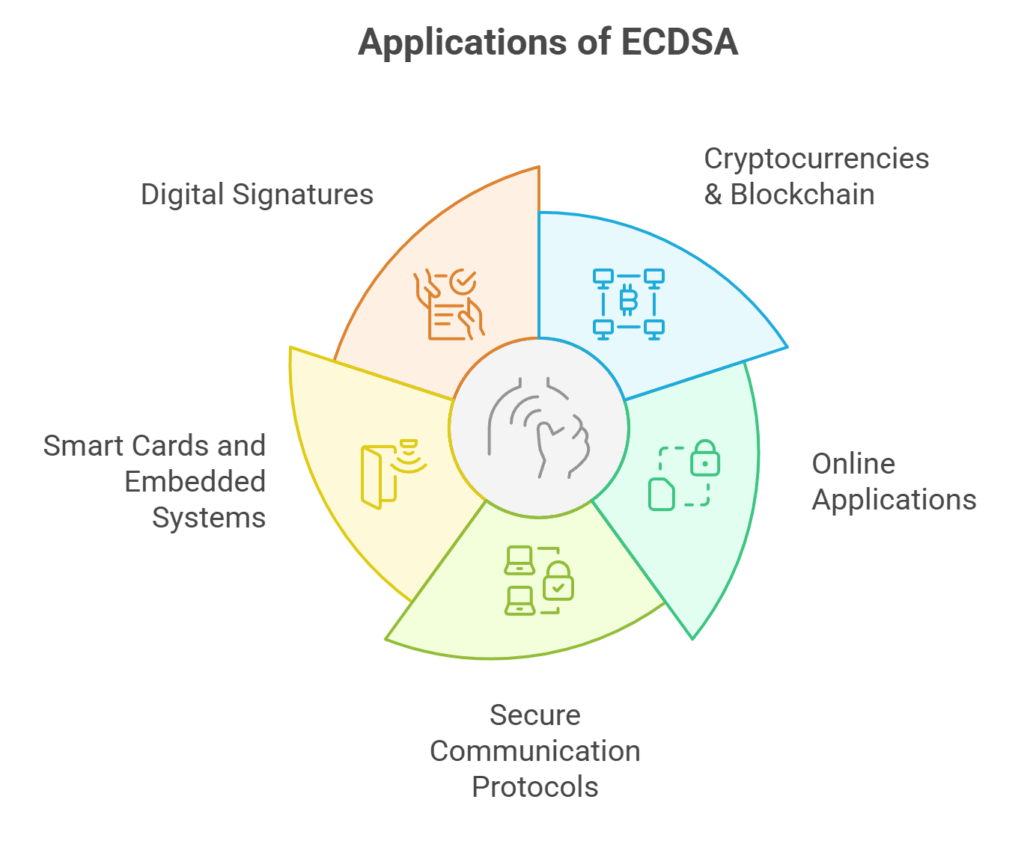What is ECDSA?

A complicated public-key cryptography encryption method for digital signatures is the Elliptic Curve Digital Signature Algorithm. Ethereum and Bitcoin use it to secure transactions and verify legality.
- A digital signature algorithm (DSA) that makes use of keys produced from elliptic curve cryptography (ECC) is called the Elliptic Curve Digital Signature Algorithm (ECDSA). This equation, which is based on public key cryptography (PKC), is especially effective.
- ECDSA is the foundation of Bitcoin security (with Bitcoin “addresses” acting as public keys), and it is widely utilised in secure messaging applications.
- ECDSA also encrypts connections between web browsers and online applications for Transport Layer Security (TLS), the replacement for Secure Sockets Layer (SSL). Signed certificates utilising ECDSA are used to establish an encrypted connection to an HTTPS website, as indicated by the browser’s display of an actual padlock picture.
- ECDSA’s ability to offer a higher level of security with shorter key lengths sets it apart from another well-known algorithm, RSA. Since ECDSA requires less processing power than RSA, a less secure competing equation, this further boosts its return on investment.
For instance, “ECDSA offers strong, effective encryption.” For this reason, it is used by a lot of messaging apps and other systems that send data over the wire.
Core Purpose and Basis
ECDSA makes it possible for organisations to digitally sign communications and for third parties to confirm the legitimacy of such signatures. Unlike handwritten signatures, it prevents forgeries and applies to the entire message, functioning as an electronic counterpart of a handwritten signature. Its foundation is Elliptic Curve Cryptography (ECC), which uses elliptic curves with finite fields and their algebraic structure. The Elliptic Curve Discrete Logarithm Problem’s (ECDLP) computational difficulty is the source of ECDSA’s security. This indicates that while multiplying a point P on an elliptic curve by a multiplier k to obtain another point Q is simple, figuring out k using just points P and Q is computationally impossible. Even if the public key and other pertinent characteristics are known, it is very difficult to determine the private key due to its intractability.
Also Read About Asymmetric Cryptography Algorithms & Examples in Blockchain
Asymmetric Cryptography and Key Pairs
Asymmetric-key encryption, sometimes referred to as public-key encryption, is used by ECDSA. A private key and a public key are two mathematically related keys that are involved in this.
- The private key must be kept secret by its owner and is usually a randomly selected number within a given range, usually 256 bits. Messages are signed using it.
- An EC point, which is a pair of integer coordinates (x, y) that lie on the curve, is the public key. The elliptic curve cryptography algorithm and a generator point G (also known as a base point or reference point) on the curve are used to derive it from the private key. It is practically hard to reverse the procedure, even though it is computationally possible to determine the public key from the private key. The private key and signatures are validated using the public key.
Key Generation (ECDSA Key Pair Creation)
- A particular set of EC domain settings is associated with an ECDSA key pair.
- An entity A selects a random integer d (the private key) from the rangen-1], where n is the integer order of the base point G, in order to generate a key pair.
- Then, using the elliptic curve point multiplication formula Q = dG, the public key Q is determined.
Signature Generation
In order to sign a message m, Alice, the sender, and Bob, the recipient, must first agree on the curve parameters (CURVE, G, n). The basis point G’s order n needs to be prime.
After that, Alice does:
- For an integer output, calculate e = HASH(m), where HASH is a cryptographic hash function like SHA-2.
- It define L as the group order n bit length and z as e’s leftmost L bits.
- Select an n-1 nonce, or cryptographically secure random integer, K. The private key may be compromised if k is static (not random) or produced by a flawed random number generator. This can be avoided by using the message and private key to deterministically derive k.
- Determine where (x1, y1) = kG is the curve point. The signature frequently uses the x-coordinate of this R point.
- Determine that r = x1 mod n. Return to step 3 if r = 0.
- S = k-1 (z + rdA) mod n can be computed. Return to step 3 if s = 0.
- Signing pair (r, s). The recovery ID (v), a single-byte value in Ethereum signatures, carries the public key verification information.
Also Read About Role Of Cryptography In Blockchain Explained For Beginners
Signature Verification
Alice’s public-key curve point QA must be in Bob’s possession in order for him to authenticate Alice’s signature (r, s) on a message m. It is recommended that Bob first confirm the public key and domain specifications.
Bob then takes the subsequent actions:
- Verify that the integers r and s are inside the range [-1]. The signature is void otherwise.
- Utilising the same hash function that was used for signing, compute e = HASH(m).
- Let z be the leftmost Ln bits of e.
- Figure out w = s-1 mod n.
- Do the calculations for u1 = ew mod n and u2 = rw mod n.
- Determine the curve point X = u1G + u2Q, where Q is the public key of the signer and G is the generator point. The signature is void if the identity element, X, equals O.
- The x-coordinate x1 of X should be converted to an integer.
- If and only if v = x1 mod n (or r ≡ x1 (mod n)), the signature is legitimate. The signature is legitimate if the public key that was recovered (from v, r, and s) matches the sender’s known public key.
Public Key Recovery
- The public key of the signer may be recovered given a message m and a signature (r, s).
- In this procedure, curve points are determined using r, intermediate values are computed using z (from the message hash), r, and s, and QA is then determined using these values and the generator point G.
- If you already know the public key (or hash) of the signer, you can use this recovery procedure to verify the authenticity of a signature.
Benefits of ECDSA
Reduced Key Size and Efficiency
ECDSA uses smaller keys than RSA but provides comparable security. Example: A 256-bit ECDSA public key provides security comparable to a 3072-bit RSA public key. Smaller keys use less computational power, process data faster, and take up less space. It is suited for resource-constrained situations like blockchain networks, smart cards, embedded systems, and mobile phones.
High Security
Its complexity and reliance on ECDLP make it more resistant to contemporary attack methods and quantum computing attacks than RSA. The NSA permits its usage for safeguarding data classified up to top secret with 384-bit keys, whereas the US government mandates ECC with 256 or 384-bit key sizes for internal communications depending on sensitivity levels.
Quick Key Generation
Private keys are created quickly by safely generating a random number.
Low Latency
By computing signatures in two steps, latency can be reduced.
Government Standard Compliance
ECDSA is an ISO, ANSI, IEEE, and NIST-accepted approach for asymmetric key functions that has been authorised by FIPS (FIPS 140-2).
Also Read About Types Of Blockchain Wallets: Hot, Cold, Hardware And More
Limitations and Vulnerabilities
Implementation Complexity
Compared to RSA, ECDSA is more complicated and challenging to safely implement, which raises the possibility of implementation errors. Algorithms with poor implementation can jeopardise security.
Large Encryption Size
Compared to RSA encryption, ECDSA has a far greater capacity to enlarge the encrypted message.
Faulty Random Number Generation
The secret key may be recovered if the cryptographically secure random integer k (nonce) is produced using a flawed or compromised random number generator. This was demonstrated by the Android Bitcoin Wallet vulnerability and the PlayStation 3 signing key hack.
Standard Curve Issues
Previous disclosures of NSA possibly introducing backdoors have raised questions regarding the reliability of NIST-generated curves.
Binary Curves
Binary curve processing can be expensive and subject to patent disputes.
Malleability of Signatures
Because elliptic curves around the x-axis are symmetric, one signer may have two valid signatures at any point on the curve, which enables attackers to calculate a second valid signature without the private key. Replay attacks may result from this.
ECDSA applications

Cryptocurrencies & Blockchain Technology
ECDSA is essential to blockchain for safeguarding transactions and confirming legitimacy. It is currently the most widely used signature system on Ethereum and in Bitcoin. The secp256k1 curve is utilised by Bitcoin. ECDSA signs transactions in these coins and creates public/private key pairs. An ECDSA public key is hashed to establish a Bitcoin address, and the account is owned by the owner of the private key. Additionally, Ethereum 2.0 makes extensive use of pairs of elliptic curves with BLS signatures.
Online Applications
Because of its efficiency and smaller key size, this encryption standard is being utilised more and more in online applications. This includes software, data, and emails that are encrypted only in one direction.
Secure Communication Protocols
To facilitate encryption, digital signatures, and key exchange, ECC is utilised in a number of protocols, including Transport Layer Security (TLS), Secure Shell (SSH), and Virtual Private Networks (VPNs). TL S connections and page loading are faster with smaller public keys and certificates.
Smart Cards and Embedded Systems
ECC is used to protect access control, payment, and electronic passport systems in low-resource devices, especially smart cards and embedded systems.
Digital Signatures
Creates digital signatures, pseudo-random numbers, and other data. It verifies data integrity and validity without compromising data security.
Implementation
ECDSA can be implemented in Python (tinyec and ecdsa packages), C language, C++, Java, and OpenSSL.
